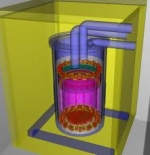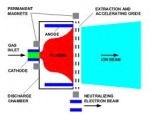Displaying items by tag: Xenon
XENON Dark Matter Search Experiment
The XENON Dark Matter Search Experiment aims to construct a next-generation dark matter detector, which will use liquid xenon as the target material for finding Weakly interacting massive particles (WIMPs). The collaboration is led by the Columbia University.
A 15 kg liquid xenon detector was installed at Gran Sasso underground laboratory in Italy during March 2006, and searchedfor WIMP interactions until October 2007. No WIMP signatures were found, the limits on WIMP-nucleon cross sections extend down to below 10−43cm2 for a 30 GeV/c2 WIMP mass.
The current phase, XENON100, for a total of 150 kg of liquid Xenon, is running at the Gran Sasso Laboratory. XENON100 is expected to achieve a factor of 50 better sensitivity, compared to XENON10. The next generation XENON detector will reach another order of magnitude sensitivity to cover SUSY parameter space down to 10−46cm2 by 2012.
The collaboration is currently designing Xenon1t whose fiducial volume will contain 1 ton of ultra radio-pure liquid Xenon.
Participating universities in XENON100 include: Columbia University (USA), Johannes Gutenberg Universitat, Mainz (Germany), Gran Sasso National Laboratory (Italy), Max-Planck-Institut fur Kernphysik (Germany), Rice University (USA), Shanghai Jiao Tong University (China), SUBATECH, Universite de Nantes (France), University of Bologna andINFN-Bologna (Italy), University of California - Los Angeles (USA), University of Coimbra (Portugal), University of Munster (Germany), University of Zurich (Switzerland),Weizmann Institute of Science (Israel)
Participating laboratories in XENON10 include: Brown (USA), Case Western Reserve (USA), Columbia (USA), Gran Sasso National Laboratory (Italy), Lawrence Livermore National Laboratory (USA), Rice (USA), Coimbra (Portugal), University of Zurich (Switzerland), and Yale (USA).
XIPS - Xenon Ion Propulsion System
XIPS is a com-mercial electron bom-bardment thruster (also known as an electrostatic ion thruster) – a form ion propulsion – that is a product of Hughes Space and Communications Company, which, in 2000, became part of Boeing Satellite Systems.
XIPS (pronounced "zips") employs the heavy inert gas xenon as a propellant. It was first used operationally aboard the PAS-5 (PanAmSat-5) communications satellite in 1997 and has since been fitted to many other geosynchronous satellites for use primarily in station-keeping. In a XIPS, xenon atoms are injected into an ionization chamber and ionized by electron bombardment. The propellant is then electrostatically accelerated through a series of biased grids. Ions, ejected by XIPS, travel in a stream at a speed of 30 km/s (62,900 mph), nearly 10 times that of a conventional chemical thruster. The high efficiency of the system leads to a reduction in propellant mass of up to 90% for a satellite designed for 12–15 years operation.
For example on a XIPS equipped Boeing 702 satellite, four 25-cm thrusters provide economical station keeping, needing only 5 kg of fuel per year. Boeing asserts that this is "a fraction of what bipropellant or arcjet systems consume". Boeing further asserts, that a XIPS can be used for final orbit insertion and has orders ( source: Wikipedia, Boeing_702 ) for spacecraft utilizing only ion thrusters. This conserves even more payload mass, as compared to using an on-board liquid apogee engine.


